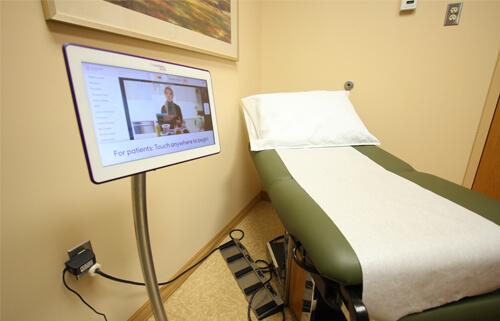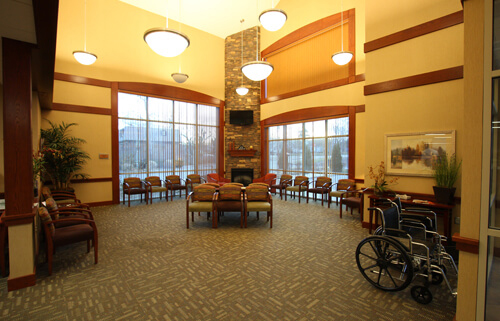Endoscopic mucosal resection (EMR) is a specialized therapeutic technique performed during an upper endoscopy (EGD) or colonoscopy to remove pre-cancerous, cancerous or other abnormal lesions from the lining of the gastrointestinal (GI) tract. This technique is a less invasive alternative to surgery removal of lesions, which may be early-staged cancer or pre-cancerous. EMR allows doctors to determine the depth of cancer invasion into tissues beneath the GI tract.
As EMR requires careful skill in order to perform it safely and effectively, it should only be performed by Louisville gastroenterologist, like your GHP physician, who have more specialized training in this technique than a standard gastroenterologist.
What is Involved in EMR?
EMR can be performed to remove lesions in both the upper and lower GI tract via an upper endoscopy (EGD) or a colonoscopy. An EGD uses an endoscope, which is a thin, flexible tube with a camera at the tip, to access the upper digestive tract (consisting of the esophagus, stomach and duodenum). A colonoscopy also uses an endoscope, but accesses the large intestine, or the colon. Both techniques provide live images via the endoscope to a video monitor so that your GHP physician can visualize these areas in order to remove the lesions with precision and care.
How Do You Prepare for the Procedure?
Before undergoing EMR treatment, your GHP physician will go over some pre-operative instructions that you will need to follow in the days before your procedure. Following these instructions is essential to limit surgery risks and provide the best results.
- Stop certain medications. your GHP physician and their staff will need to be made aware of all medications that you are taking, especially blood-thinning medications. These may include Coumadin (warfarin), Plavix (clopidogrel), Xarelto (rivaroxaban), Pradaxa (dabigatran), Eliquis (apixaban) and Lovenox (enoxaparin). Since the use of these medications increases the risk of excessive bleeding, they should be stopped prior to your procedure. If you are using insulin, the dosage or timing will also need to be adjusted the day of the procedure. Doctor-prescribed aspirin CANNOT be continued before your procedure. In addition, your GHP physician asks that you provide them with a list of medications to which you are allergic.
- Stop eating hours beforehand. Refrain from eating anything starting the midnight before your procedure is scheduled.
- Use our cleansing routine the day before (for EMR via colonoscopy only). Your GHP physician’s office will prescribe a cleansing routine (or “prep”), which consists of a powerful liquid laxative that is to be taken the day before the procedure in order to prepare your bowels. This cleansing routine is the MOST IMPORTANT part of the procedure. Following directions and having a good cleanse can decrease the need for an earlier repeat colonoscopy. Your GHP physician’s office will give you further instructions on following this cleansing routine and other details to follow on the day before the procedure. These instructions include following a clear liquid diet the day before the procedure, and drinking lots of liquids.
What Happens During EMR?
EMR is performed via an EGD or a colonoscopy, both of which are outpatient procedures. When you check in, you will be escorted to the “pre-op” area where an IV will be placed and nurses will take down your medical information. At this time, you will also meet with an anesthesiologist to discuss the sedation used for the procedure.
You will then be taken to a procedure room and connected to monitors that will monitor your blood pressure, heart rate and blood oxygen levels throughout the course of the procedure. Once this is finished, you will then be sedated for the duration of the procedure (not awakening until after it is complete). The procedure itself takes anywhere from 10 to 30 minutes to complete, depending on the type of procedure performed. If the EMR treatment is performed via EGD, you will be placed on your left side, a “bite block” will be inserted into your mouth, and the endoscope will then be passed through your mouth. If the EMR is performed via a colonoscopy, you will be placed on your left side so that the colonoscope can be inserted into the anus and advanced to the end of the colon.
During either exam, the lesion will be identified and assessed for removal by EMR. There are several techniques used to perform EMR depending on the type, size and location of the lesion. One technique uses a special needle that is passed through the scope and inserted at the base of the lesion. Fluid, along with a blue-colored dye, are then injected under the lesion to “lift” it off and away from the muscle layer of the bowel lining, creating a sort of “pillow” under the lesion; though some lesions may not require the placement of this “pillow” prior to removal.
In another technique, the endoscope may be equipped with a device that allows the lesion to be suctioned into a cap attached to the tip of the scope, where the lesion is then separated from the lining of the GI tract by a specially placed rubber band prior to removal.
Once the lesion has been separated from the GI tract, a snare (wire lasso) is passed around the lesion and pulled tight. Electric current is then passed through the snare, cutting the lesion off and cauterizing (heating) the blood vessels. Larger lesions may require multiple pieces to be removed similarly, after which they will be collected and analyzed in the laboratory.
What Should You Expect after the Procedure?
Following an EMR procedure, you will go to the “post-op” area to recover from sedation; there you will also be monitored for any potential complications from the procedure and/or sedation.
Once you are fully recovered, your GHP physician will provide you with an explanation of the findings from your procedure, along with a copy of the procedure report, patient information handouts and follow-up instructions. He will give you a full preliminary report at this time; however, it may take several days for the final results of biopsies removed to return.
Due to the effects of sedation, patients are instructed not to drive, operate machinery or make important decisions for the 24 hours following the procedure. We also recommend that you have someone drive you home after surgery.
You will be able to eat after you leave the hospital, unless instructed otherwise. Your GHP physician recommends clear liquids to start, followed by bland foods, and will give instructions for when you should switch from liquids to food. The nursing staff will review these and other important post-op instructions with you prior to discharge.
Possible Complications and Risks
Risks associated with EMR include bleeding, which occurs in 5-10 percent of patients. Bleeding can be stopped during the procedure, if it is recognized. However, patients may have delayed bleeding that might be severe and require hospitalization, blood transfusion and further procedures to control.
A possible major complication is a perforation, which is a tear through the lining of the intestine. This risk is also rare, as it occurs in only 1-2 percent of cases. In some of these instances, the perforation can be managed with hospitalization, IV fluids, antibiotics to prevent infection and bowel rest. However, some perforations may require surgery to repair.
Uncommon risks from the sedation used for the procedure include reactions to sedation medications, possible aspiration of stomach contents into the lungs and complications from heart and lung diseases.
Although complications from EMR are rare, it is important to recognize them early. Contact Gastroenterology Health Partner’s office if you notice severe abdominal pain, fever and chills, excessive rectal bleeding or black stools.
All of the risks listed must be balanced against the potential benefits of the procedure and the risks of alternative approaches to the condition.
Disclaimer: This information is intended to provide general guidance and does not provide definitive medical advice. It is not a definitive basis for diagnosis or treatment in any particular case. This material does not cover all information and is not intended as a substitute for professional medical care. It is important that you consult your doctor regarding your specific condition, contraindications and potential complications.





